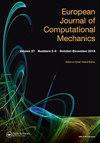Static and Dynamic Analysis of Coupled Vibration of Suspension Bridge Structure Under Earthquake Action
IF 1.5
Q3 MECHANICS
引用次数: 0
Abstract
This article investigates the coupled vibration problem of suspension bridge structures under earthquake action, and conducts static and dynamic analysis using computer algorithms. In terms of static analysis, complex structures are divided into many small elements, and the stress and deformation of each element are calculated through finite element analysis, thereby obtaining the static characteristics of the entire structure. In terms of dynamic analysis, the seismic response analysis method based on time history considers seismic action as a time-varying external excitation, and calculates and simulates the dynamic response of the suspension bridge structure. In order to achieve efficient and accurate calculations, this article also adopts optimization algorithms and numerical calculation methods. Through a comprehensive study of statics and dynamics analysis, the key characteristics and regularities of coupled vibration of suspension bridge structures under earthquake action have been obtained. These research results not only provide important theoretical guidance and technical support for related engineering practices, but also provide useful references and inspirations for dynamic analysis and optimization design of similar structures. Meanwhile, using computer algorithms and simulation software for static and dynamic analysis can significantly reduce analysis costs and time, improve analysis accuracy and efficiency, and have broad application prospects.地震作用下悬索桥结构耦合振动的静态和动态分析
本文研究了地震作用下悬索桥结构的耦合振动问题,并利用计算机算法进行了静态和动态分析。在静力分析方面,将复杂结构划分为许多小单元,通过有限元分析计算每个单元的应力和变形,从而得到整个结构的静力特性。在动态分析方面,基于时间历程的地震响应分析方法将地震作用视为时变的外部激励,计算并模拟悬索桥结构的动态响应。为了实现高效准确的计算,本文还采用了优化算法和数值计算方法。通过静力学和动力学分析的综合研究,获得了地震作用下悬索桥结构耦合振动的主要特征和规律性。这些研究成果不仅为相关工程实践提供了重要的理论指导和技术支持,也为类似结构的动力分析和优化设计提供了有益的参考和启示。同时,利用计算机算法和仿真软件进行静态和动态分析,可以大大降低分析成本和时间,提高分析精度和效率,具有广阔的应用前景。
本文章由计算机程序翻译,如有差异,请以英文原文为准。
求助全文
约1分钟内获得全文
求助全文

 求助内容:
求助内容: 应助结果提醒方式:
应助结果提醒方式:


